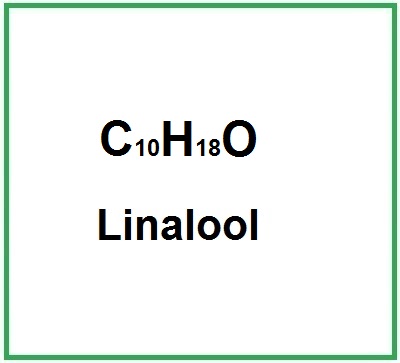![]() Linalool
Linalool
Rating : 7
| Evaluation | N. Experts | Evaluation | N. Experts |
|---|---|---|---|
| 1 | 6 | ||
| 2 | 7 | ||
| 3 | 8 | ||
| 4 | 9 | ||
| 5 | 10 |
Pros:
Possible anti-cancer (1)Cons:
Specific allergy (1)7 pts from A_Partyns
| Sign up to vote this object, vote his reviews and to contribute to Tiiips.Evaluate | Where is this found? |
| "Linalool. Studies" about Linalool Review Consensus 8 by A_Partyns (12948 pt) | 2024-Sep-22 08:18 |
| Read the full Tiiip | (Send your comment) |
Linalool (Linalol) is a natural component found in essential oils such as lavender (1), rose, coriander, orange etc.It is also found in common fruits and vegetables.
In its purest form it is used in medicine as a bioactive anti-tumor principle (2)
It is commonly used as a fragrance in the cosmetic field to perfume the products that contain it.It can be obtained from laurel, bergamot, geranium and many other flowers.In these cosmetic applications, as the linalool is easily oxidizable when in contact with air, there is a risk of skin allergy (3).
Reading many texts and reviews in cosmetic head, the linalool is cited as a dangerous component, but it does not.It is the oxidation of the product that can be potentially dangerous, as the linalool is treated in a non-sterile manner and in contact with components that can accelerate the oxidation process. It is however a component that can cause contact allergy.
It has anti-stress properties (4).
Safety
Linalool and D-limonene are common fragrance ingredients that readily oxidize on exposure to air. The resulting hydroperoxides of linalool and D-limonene have been shown to have high frequencies of positive patch test reactions in several European and international studies....In this study, the frequency of positive patch test reactions to the hydroperoxides of linalool is 20% (19/96), and the frequency of positive reactions to the hydroperoxides of D-limonene is 8% (7/90). These high frequencies suggest that patch testing to the hydroperoxides of linalool and limonene should be performed in all patients with suspected fragrance allergy (5).
It is also used as an antiparasitic.
References______________________________________________________________________
(1) Adaszyńska M, Swarcewicz M, Dzięcioł M, Dobrowolska A. Comparison of chemical composition and antibacterial activity of lavender varieties from Poland. Nat Prod Res. 2013;27(16):1497-501. doi: 10.1080/14786419.2012.724408. Epub 2012 Sep 19.
Abstract. The aim of the study was comparing the chemical composition of the essential oils from five varieties of lavender (Lavandula angustifolia L.), and its biological activity against two pathogenic bacteria, Staphylococcus aureus and Pseudomonas aeruginosa. In the comparison we included the following varieties: 'Munstead', 'Munstead Strain', 'Lavender Lady', 'Ellegance Purple' and 'Blue River'. Selected varieties of lavender (L. angustifolia) are characterised by exactly the same main compounds with only variations in the percentage of content. The primary components of the essential oils were: linalool (23.9-15.8%), linalyl anthranilate (12.3-1.6%), 1-terpinen-4-ol (9.7-5.5%), p-menth-1-en-8-ol (7.9-4.0%) and linalool oxide (4.7-1.1%). From the essential oils that were tested, the 'Blue River' and 'Munstead' varieties have the greatest antibacterial activity against S. aureus and P. aeruginosa.
(2) Chang MY, Shen YL. Linalool exhibits cytotoxic effects by activating antitumor immunity. Molecules. 2014 May 22;19(5):6694-706. doi: 10.3390/molecules19056694.
Abstract. According to recent studies, the Plantaginaceae, which are traditional Chinese herbal remedies, have potential for use in viral infection treatment and cancer therapy. Linalool and p-coumaric acid are two of the biologically active compounds that can be isolated from the Plantaginaceae. This study mainly focused on investigating the bioactivity of linalool as well as the bioactivity of p-coumaric acid in terms of their cytotoxic effects on cancer cells. Whether the mechanisms of such effects are generated through apoptosis and immunoregulatory activity were also investigated. By using WST-1 analysis, it was shown that linalool and p-coumaric acid have good inhibitory effects against breast, colorectal and liver cancer cells. The IC50 values of linalool for those cancer cell types were 224 μM, 222 μM, and 290 μM, respectively, and the IC50 values of p-coumaric acid were 693 μM, 215 μM and 87 μM, respectively. Cell cycle analysis also confirmed that linalool and p-coumaric acid can lead to apoptosis. By using flow cytometry, it was determined that treatment with linalool rather than p-coumaric acid significantly increased the sub-G1 phase and that there were more cells concentrated in the G1 phase. Furthermore, by using cytokine array analysis, we found that linalool can stimulate IFN-γ, IL-13, IL-2, IL-21, IL-21R, IL-4, IL-6sR and TNF-α secretion. This demonstrated that in addition to the bidirectional regulation capabilities found in linalool, it also induces Th1 cellular immune response in T-47D cells. These results showed that linalool holds great potential for use in cancer therapy, and we believe that it could provide an alternative way to take action against tumors.
Cherng JM, Shieh DE, Chiang W, Chang MY, Chiang LC. Chemopreventive effects of minor dietary constituents in common foods on human cancer cells. Biosci Biotechnol Biochem. 2007 Jun
Abstract. Epidemiological evidence has suggested that vegetables and fruits may have a role in cancer prevention. The aim of the present study was to examine the anti-proliferative activity of ten related pure compounds from common vegetables and fruits. Studies were conducted on a series of carcinoma cells derived from eight human organs. The results show that linalool possessed the strongest activity against nine carcinoma cells, and that baicalein and luteolin also exhibited a broad spectrum of anti-proliferative activities. Among them, linalool showed the strongest activity against carcinoma of the cervix (IC50: 0.37 microg/ml), stomach (IC50: 14.1 microg/ml), skin (IC50: 14.9 microg/ml), lung (IC50: 21.5 microg/ml) and bone (IC50: 21.7 microg/ml). As for the flavonoids, luteolin exhibited the strongest activity against carcinoma of the stomach (IC50: 7.1 microg/ml), cervix (IC50: 7.7 microg/ml), lung (IC50: 11.7 microg/ml) and bladder (IC50: 19.5 microg/ml), whereas baicalein possessed the strongest anti-proliferative activity against carcinoma of the cervix (IC50: 9.8 microg/ml), stomach (IC50: 16.1 microg/ml) and skin (IC50: 19.5 microg/ml). The present study indicates that linalool possessed the strongest activity against a broad spectrum of carcinoma cells, especially cervical carcinoma cells, suggesting that linalool and flavonoids are partially responsible for the cancer prevention of common vegetables and fruits.
(3) Bråred Christensson J, Andersen KE, Bruze M, Johansen JD, Garcia-Bravo B, Gimenez Arnau A, Goh CL, Nixon R, White IR. Air-oxidized linalool: a frequent cause of fragrance contact allergy. Contact Dermatitis. 2012 Nov;67(5):247-59. doi: 10.1111/j.1600-0536.2012.02134.x.
Deza G, García-Bravo B, Silvestre JF, Pastor-Nieto MA, González-Pérez R, Heras-Mendaza F, Mercader P, Fernández-Redondo V, Niklasson B, Giménez-Arnau AM; GEIDAC. Contact sensitization to limonene and linalool hydroperoxides in Spain: a GEIDAC* prospective study. Contact Dermatitis. 2017 Feb;76(2):74-80. doi: 10.1111/cod.12714.
(4) Souto-Maior FN, de Carvalho FL, de Morais LC, Netto SM, de Sousa DP, de Almeida RN. Anxiolytic-like effects of inhaled linalool oxide in experimental mouse anxiety models. Pharmacol Biochem Behav. 2011 Dec;100(2):259-63. doi: 10.1016/j.pbb.2011.08.029.
Takahashi M, Satou T, Ohashi M, Hayashi S, Sadamoto K, Koike K. Interspecies comparison of chemical composition and anxiolytic-like effects of lavender oils upon inhalation. Nat Prod Commun. 2011 Nov;6(11):1769-74.
Abstract. Essential oils have traditionally been used for decades to alleviate the symptoms of various mental problems. In terms of anxiolytic-like properties, lavender oil is probably the most commonly used and best-studied essential oil. Although there is compositional variance among the oils extracted from different origins, there have been few studies performed to date to investigate how these differences affect the expression of anxiolytic-like activity. This paper discusses the interspecies differences and contributions of the main constituents in the expression of anxiolytic-like effects upon inhalation, as assessed in mice by the elevated-plus maze test, by comparing the essential oils from six different species of Lavandula. The results showed qualitative and quantitative variations in the tested oils, which results in significant differences in their anxiolytic-like activities. Our findings also suggest that linalyl acetate (LA) works synergistically with linalool (LO) and that the presence of both LA and LO is essential for the whole oil to work as an inhaled anti-anxiety agent.
(5) Nath NS, Liu B, Green C, Atwater AR. Contact Allergy to Hydroperoxides of Linalool and D-Limonene in a US Population. Dermatitis. 2017 Sep/Oct;28(5):313-316. doi: 10.1097/DER.0000000000000318.
Abstract. Background: Linalool and D-limonene are common fragrance ingredients that readily oxidize on exposure to air. The resulting hydroperoxides of linalool and D-limonene have been shown to have high frequencies of positive patch test reactions in several European and international studies....Conclusions: In this study, the frequency of positive patch test reactions to the hydroperoxides of linalool is 20% (19/96), and the frequency of positive reactions to the hydroperoxides of D-limonene is 8% (7/90). These high frequencies suggest that patch testing to the hydroperoxides of linalool and limonene should be performed in all patients with suspected fragrance allergy.
| Sign up to vote this object, vote his reviews and to contribute to Tiiips.EvaluateClose | (0 comments) |
| "Descrizione" about Linalool Review Consensus 7 by A_Partyns (12948 pt) | 2024-Sep-20 19:09 |
| Read the full Tiiip | (Send your comment) |
Linalool (3,7-dimethyl-1,6-octadien-3-ol) is a monoterpene alcohol that is extracted from aromatic plants such as Lavandula sp., Ocinum Basilicum L. and other plants of the Lamiaceae and Rutaceae families. It is also extracted by organic synthesis from α, β-pinene or other terpenes and isolated from Plantaginaceae, rosewood oil, carrageenan oil, coriander oil and eucalyptus oil. Linalool is oxidised to form Citral, a substance that can also be used to chemically produce many other flavourings.
The name describes the structure of the molecule:
- Linal is derived from 'linaloe', which is a type of wood from trees belonging to the Burseraceae family. Linalool was first isolated from linaloe oil, hence the name.
- ool is a suffix used in organic chemistry to indicate substances that are alcohols. In the case of linalool, it refers to the presence of a hydroxyl functional group (-OH) in the molecule.
Natural chemical synthesis:
- Linalool is produced naturally by plants during photosynthesis. It is synthesised as part of plant metabolism and is responsible for emitting their characteristic aroma.
The industrial synthesis process takes place in different steps:
- Raw material extraction. Linalool is extracted from plants that produce it in high quantities, such as lavender, mint and coriander. The plant material is collected and prepared for extraction.
- Distillation. The plant material undergoes steam distillation, a process in which steam causes the plant cells to break down and release the oils, including linalool.
- Condensation and separation. The mixture of steam and oil is cooled and condensed and the resulting liquid is a mixture of water and oil, which can be separated because oil and water do not mix. The oil layer, which contains linalool, is collected.
- Purification. The oil is further purified to isolate the linalool by various methods, including fractional distillation, in which the oil is heated and the components that vaporise at different temperatures are separated.
- Quality control. Linalool is tested to ensure that it meets the necessary quality standards.
Linalool occurs as a clear, colourless to pale yellow liquid, relatively soluble in water and highly soluble in many organic solvents.

What it is used for and where it is used
Medicine
Due to its high penetration potential and its affinity for cell membranes, it has the ability to bind to various molecular structures such as protein glycoproteins. It exists in two enantiomers with different pharmacological effects: (R)-linalool works as an anti-stress agent, (S)-linalool increases heart rate.
It is known to have anti-inflammatory, anti-cancer, anti-hyperlipidaemia, antibacterial and neuroprotective properties (1).
Food
It is an ingredient approved by the Food and Drug Administration (FDA) as GRAS so it is recognised as a safe food additive and is included to impart fragrance to food products in which it is incorporated. It is frequently used as a flavouring in butter, grapes, apricots, pineapples. Oxidation must be avoided.
Cosmetics
It is a chemical intermediate component. Fragrance included in toothpastes, sunscreens, lipsticks, deodorants, lip balms. It is a component that is considered safe if it is not oxidised, so remember to close the cap of the package in which it is inserted tightly to prevent air from penetrating inside for a long time and causing oxidation not only of this, but also of any other oxidation-sensitive components.
Deodorant agent. When substances that give off an unpleasant odour are included in cosmetic formulations (typical examples are methyl mercaptan and hydrogen sulphide derived from garlic), deodorants attenuate or eliminate the unpleasant exhalation.
Perfuming. Unlike fragrance, which can also contain slightly less pleasant or characteristic odours, the term perfume indicates only very pleasant fragrances. Used for perfumes and aromatic raw materials.
Pharmaceutical
Fragrance in various drug formulations e.g. anti-caries.
Other uses
Tobacco, insecticides
The most relevant studies and their abstracts have been selected to explore this in more depth:
Typical optimal commercial product characteristics Linalool
| Appearance | Clear colourless to pale yellow liquid |
| Boiling point | 194-197 °C/720 mmHg (lit.) |
| Melting Point | 25°C |
| Density | 0.87 g/mL at 25 °C (lit.) 0.9±0.1 g/cm3 |
| Flash Point | 76.1±0.0 °C |
| Vapour Pressure | 0.1±0.8 mmHg at 25°C |
| pH | 4.5 (1.45g/l, H2O, 25℃) |
| pka | 14.51±0.29 |
| Specific Gravity | 0.860 (20/4℃) |
| Explosive Limit | 0.9-5.2%(V) |
| Water Solubility | 1.45 g/L (25ºC) |
| PSA | 20.23000 |
| LogP | 3.28 |
| Storage | 2-8°C |
| Safety |  |
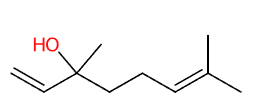 | 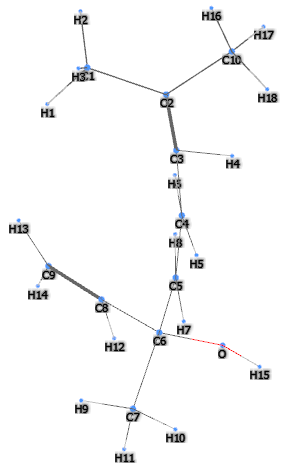 |
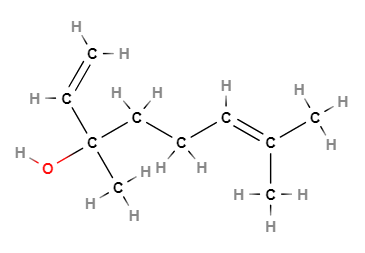 | 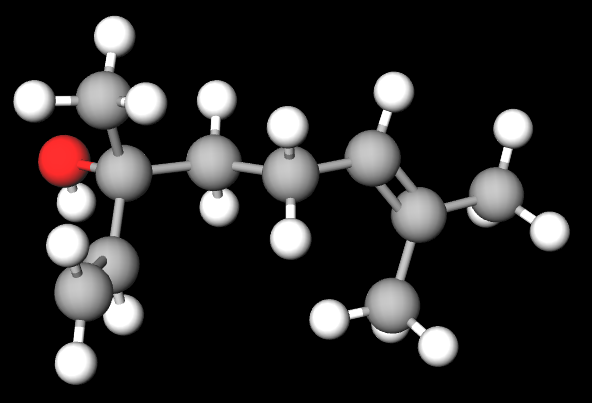 |
- Molecular Formula C10H18O (CH3)2C=CH(CH2)2C(CH3)(OH)CH=CH2
- Molecular Weight 154.25
- Exact Mass 154.135757
- CAS 78-70-6
- UNII D81QY6I88E
- EC Number 201-134-4
- DSSTox Substance ID DTXSID7025502
- IUPAC 3,7-dimethylocta-1,6-dien-3-ol
- InChI=1S/C10H18O/c1-5-10(4,11)8-6-7-9(2)3/h5,7,11H,1,6,8H2,2-4H3
- InChl Key CDOSHBSSFJOMGT-UHFFFAOYSA-N
- SMILES CC(=CCCC(C)(C=C)O)C
- MDL number MFCD00008906
- PubChem Substance ID 24896318
- Beilstein 1721488
- NACRES NA.22
- ChEBI 17580
- ICSC 0912
- JECFA 356
- FEMA 2635
- RTECS RG5775000
Synonyms :
- 3,7-Dimethylocta-1,6-dien-3-ol
- Linalol
- 1,6-Octadien-3-ol, 3,7-dimethyl-
- 2,6-Dimethyl-2,7-octadien-6-ol
- 3,7-dimethyl-octa-1,6-dien-3-ol
- 2,7-Octadien-6-ol, 2,6-dimethyl-
- (1)-3,7-Dimethyl-1,6-octadien-3-ol
- dl-3,7-Dimethyl-3-hydroxy-1,6-octadiene
References_________________________________________________________________________
(1) Pereira I, Severino P, Santos AC, Silva AM, Souto EB. Linalool bioactive properties and potential applicability in drug delivery systems. Colloids Surf B Biointerfaces. 2018 Nov 1;171:566-578. doi: 10.1016/j.colsurfb.2018.08.001.
An Q, Ren JN, Li X, Fan G, Qu SS, Song Y, Li Y, Pan SY. Recent updates on bioactive properties of linalool. Food Funct. 2021 Nov 1;12(21):10370-10389. doi: 10.1039/d1fo02120f. PMID: 34611674.
Abstract. Natural products, including essential oils and their components, have been used for their bioactivities. Linalool (2,6-dimethyl-2,7-octadien-6-ol) is an aromatic monoterpene alcohol that is widely found in essential oils and is broadly used in perfumes, cosmetics, household cleaners and food additives. This review covers the sources, physicochemical properties, application, synthesis and bioactivities of linalool. The present study focuses on the bioactive properties of linalool, including anticancer, antimicrobial, neuroprotective, anxiolytic, antidepressant, anti-stress, hepatoprotective, renal protective, and lung protective activity and the underlying mechanisms. Besides this, the therapeutic potential of linalool and the prospect of encapsulating linalool are also discussed. Linalool can induce apoptosis of cancer cells via oxidative stress, and at the same time protects normal cells. Linalool exerts antimicrobial effects through disruption of cell membranes. The protective effects of linalool to the liver, kidney and lung are owing to its anti-inflammatory activity. On account of its protective effects and low toxicity, linalool can be used as an adjuvant of anticancer drugs or antibiotics. Therefore, linalool has a great potential to be applied as a natural and safe alternative therapeutic.
Singh S, Mishra A. Linalool: Therapeutic Indication And Their Multifaceted Biomedical Applications. Drug Res (Stuttg). 2024 Jul;74(6):255-268. doi: 10.1055/a-2321-9571. Epub 2024 Jul 5. PMID: 38968949.
Abstract. This comprehensive review endeavors to illuminate the nuanced facets of linalool, a prominent monoterpene found abundantly in essential oils, constituting a massive portion of their composition. The biomedical relevance of linalool is a key focus, highlighting its therapeutic attributes observed through anti-nociceptive effects, anxiolytic properties, and behavioral modulation in individuals affected by dementia. These findings underscore the compound's potential application in biomedical applications. This review further explores contemporary formulations, delineating the adaptability of linalool in nano-emulsions, microemulsions, bio-capsules, and various topical formulations, including topical gels and lotions. This review covers published and granted patents between 2018-2024 and sheds light on the evolving landscape of linalool applications, revealing advancements in dermatological, anti-inflammatory, and antimicrobial domains. Thieme. All rights reserved.
Letizia CS, Cocchiara J, Lalko J, Api AM. Fragrance material review on linalool. Food Chem Toxicol. 2003 Jul;41(7):943-64. doi: 10.1016/s0278-6915(03)00015-2.
| Sign up to vote this object, vote his reviews and to contribute to Tiiips.EvaluateClose | (0 comments) |
Read other Tiiips about this object in __Italiano (2)
Component type: Chemical Main substances: Last update: 2022-11-28 21:28:21 | Chemical Risk: |


